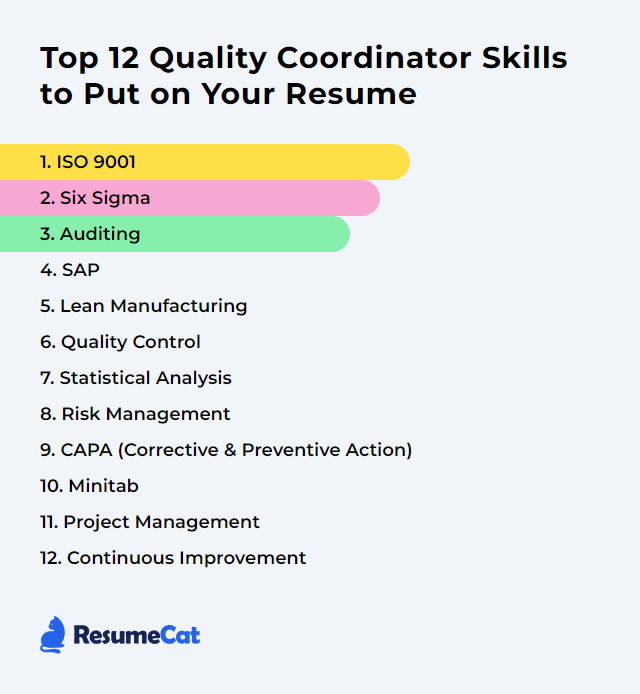Top 12 Quality Coordinator Skills to Put on Your Resume
A quality coordinator plays a pivotal role in ensuring that products and services meet organizational standards and customer satisfaction. Highlighting a well-rounded set of skills on your resume can strengthen your chances of landing this role, showing you can keep quality high across processes, teams, and time.
Quality Coordinator Skills
- ISO 9001
- Six Sigma
- Auditing
- SAP
- Lean Manufacturing
- Quality Control
- Statistical Analysis
- Risk Management
- CAPA (Corrective and Preventive Action)
- Minitab
- Project Management
- Continuous Improvement
1. ISO 9001
ISO 9001 is the international standard for a quality management system (QMS). Organizations use it to show they consistently provide products and services that meet customer and regulatory requirements while driving continual improvement. For a Quality Coordinator, it’s the backbone for building and sustaining reliable processes.
Why It's Important
ISO 9001 provides a proven framework for consistent quality practices. It helps align processes, meet regulatory and customer requirements, and lift customer satisfaction and operational efficiency. For a Quality Coordinator, it’s the reference point for monitoring, managing, and improving quality, end to end.
How to Improve ISO 9001 Skills
Strengthen ISO 9001 execution with focused, practical moves:
Run a gap analysis to pinpoint where the QMS diverges from requirements. Target those gaps with clear actions.
Engage employees through role-specific training and frequent communication. A visible quality culture beats policing.
Optimize processes by removing waste, clarifying handoffs, and error-proofing. Lean and Six Sigma tools help.
Use data to drive decisions. Monitor trends, prevent nonconformities, and prioritize improvements with facts, not hunches.
Close the loop on customer feedback. Make it structured, frequent, and actionable.
Audit internally on a risk-based schedule. Calibrate auditors, focus on process effectiveness, and fix root causes.
Hold management reviews that surface risks, resources, and breakthroughs. Track follow-through relentlessly.
Champion continuous improvement with small experiments and standardized wins that stick.
Stay current on evolving guidance and industry practices. Refresh procedures as your organization changes.
Use external guidance and peer networks to benchmark and spark ideas without reinventing the wheel.
How to Display ISO 9001 Skills on Your Resume

2. Six Sigma
Six Sigma is a data-driven method to shrink defects and variability, improve processes, and boost quality and efficiency. In practice, a Quality Coordinator applies tools across DMAIC or DMADV to measure, analyze, and optimize performance with measurable results.
Why It's Important
It turns guesswork into evidence. Six Sigma helps cut defects, stabilize processes, and deliver reliable outcomes that customers notice, while reducing cost and rework.
How to Improve Six Sigma Skills
Push Six Sigma deeper and wider:
Keep learning. Refresh on DMAIC, regression, DOE, SPC, and practical statistics.
Use the right tools for analysis and workflow. Minitab, SigmaXL, or even R/Python if your data needs scale.
Go cross-functional. Apply Six Sigma in operations, service, supply chain, finance—where variability hurts most.
Mine customer feedback for CTQs (critical-to-quality) and VOC. Let the customer define “good.”
Blend Lean with Six Sigma. Remove waste, then reduce variation. Faster and steadier in tandem.
Review projects regularly. Kill low-value work, double down on measurable wins.
Build a CI culture. Make improvement part of daily work, not a side project.
How to Display Six Sigma Skills on Your Resume
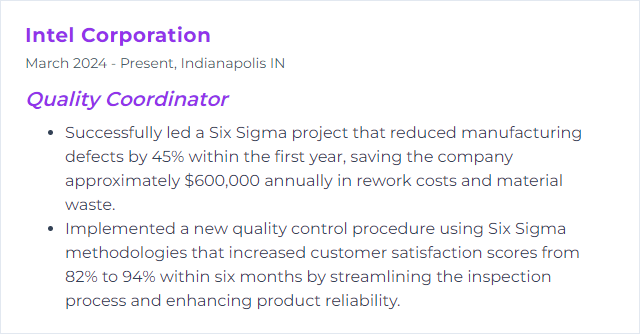
3. Auditing
Auditing is the systematic evaluation of quality processes and systems to verify compliance, effectiveness, and alignment with objectives. It uncovers risks, validates controls, and directs improvements.
Why It's Important
It provides an objective lens. Audits confirm what works, reveal what fails, and ensure the organization meets standards and regulations while improving continually.
How to Improve Auditing Skills
Make audits sharper and more useful:
Train auditors on standards, process auditing, and effective questioning. Calibrate them to reduce bias.
Engage stakeholders. Co-create audit scopes, align on risk, and share outcomes transparently.
Adopt audit software for planning, evidence, nonconformity tracking, and analytics.
Use PDCA to refine your audit program. Track time-to-closure and recurrence rates.
Embed best practices from internal auditing bodies and ISO guidance. Keep criteria relevant and risk-based.
How to Display Auditing Skills on Your Resume
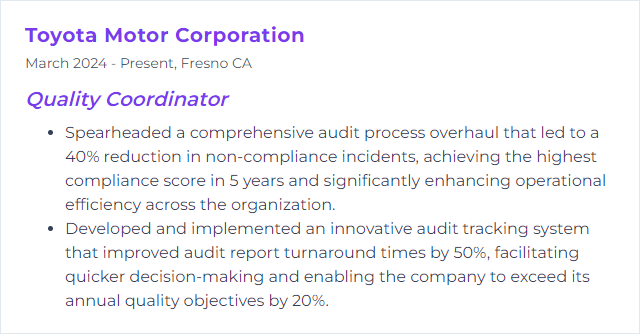
4. SAP
SAP is an enterprise resource planning suite that integrates finance, supply chain, manufacturing, and quality. For Quality Coordinators, the Quality Management (QM) capabilities help manage inspections, control results, handle deviations, and ensure compliance efficiently across the lifecycle.
Why It's Important
It ties quality to the rest of the business. Traceability gets easier, data is real-time, and process controls can be embedded right where work happens.
How to Improve SAP Skills
Get more value from SAP in quality:
Streamline processes using SAP Best Practices and Fiori apps to cut clicks and confusion.
Protect data integrity with strong master data governance, clear ownership, and validation rules.
Train users with role-based learning and quick reference guides to reduce errors and tickets.
Automate wisely with SAP Build Process Automation (formerly SAP Intelligent RPA) to eliminate repetitive steps.
Leverage SAP S/4HANA QM for in-process and final inspections, sampling, notifications, and integrations to nonconformance/CAPA workflows.
Run feedback loops with end users. Prioritize pain points and iterate.
Integrate with MES, LIMS, and supplier systems through SAP Integration Suite for seamless data flow.
How to Display SAP Skills on Your Resume
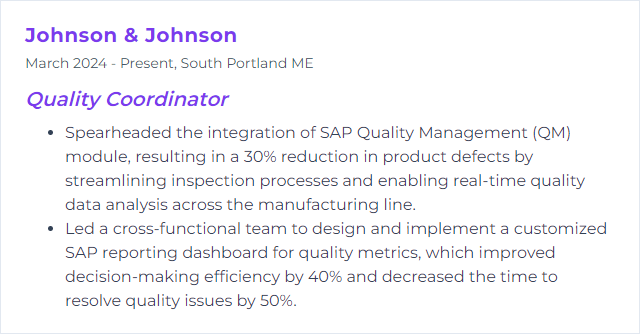
5. Lean Manufacturing
Lean Manufacturing reduces waste and boosts flow to maximize customer value. For a Quality Coordinator, it means creating stable, predictable processes that prevent defects and accelerate delivery.
Why It's Important
Lean clears friction. Less rework, fewer delays, more consistent quality—customers feel the difference and costs drop.
How to Improve Lean Manufacturing Skills
Anchor Lean in daily operations:
Value Stream Mapping to see end-to-end flow and remove non-value-added steps.
5S to organize workspaces, reduce motion, and make abnormalities obvious.
Kaizen for steady, incremental gains. Small teams, short cycles, visible results.
Root Cause Analysis using 5 Whys and Fishbone to fix causes, not symptoms.
Standard Work that documents the best-known method and evolves as improvements land.
Engage and train employees. Empower problem-solvers; recognize improvements openly.
How to Display Lean Manufacturing Skills on Your Resume
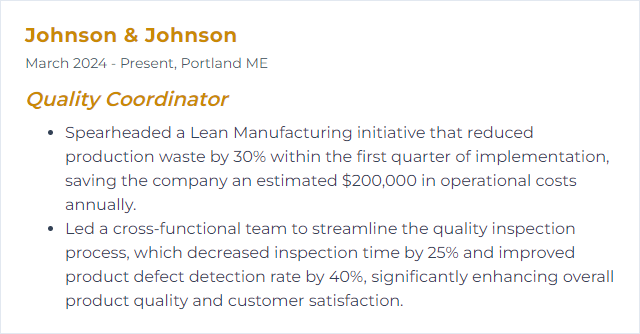
6. Quality Control
Quality Control ensures products meet specifications before release, relying on inspection, testing, and corrective actions. A Quality Coordinator orchestrates these activities so quality stays consistent and predictable.
Why It's Important
It protects customers and the brand. Strong QC minimizes defects, reduces returns, and reinforces trust while cutting cost of poor quality.
How to Improve Quality Control Skills
Level up QC with clarity and discipline:
Define standards with measurable specs, sampling plans, and acceptance criteria linked to customer needs.
Establish a QMS that aligns processes, roles, and documentation.
Train constantly on inspection methods, defect coding, and escalation paths.
Monitor with SPC and layered process audits. Act on signals early.
Close feedback loops from customers, service, and production to catch issues fast.
Do root cause analysis (5 Whys, Fishbone) and verify effectiveness of fixes.
Use the right tools like control plans, gage R&R, and digital checklists to standardize and sustain.
Build a quality culture where anyone can stop the line and quality wins over speed.
How to Display Quality Control Skills on Your Resume
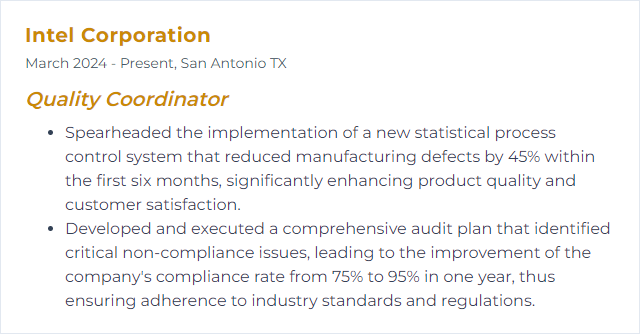
7. Statistical Analysis
Statistical analysis turns raw data into insight—patterns, trends, relationships—that sharpen decisions and fuel improvement.
Why It's Important
For a Quality Coordinator, statistics validate stability, signal drift, and quantify improvement. Data speaks; action follows.
How to Improve Statistical Analysis Skills
Make your analysis rigorous and practical:
Solidify fundamentals in probability, sampling, hypothesis testing, and confidence intervals.
Master SPC and control charts to separate noise from signal.
Apply DOE to identify key factors, interactions, and optimal settings.
Use capable tools such as Minitab, R, or Python for repeatable, auditable analysis.
Clean data diligently—define rules, manage outliers, and document assumptions.
Visualize with clear charts that tell the story quickly and accurately.
Collaborate with engineers, operators, and stakeholders to frame the right questions.
Practice on real projects and review results with peers to refine methods and interpretation.
How to Display Statistical Analysis Skills on Your Resume
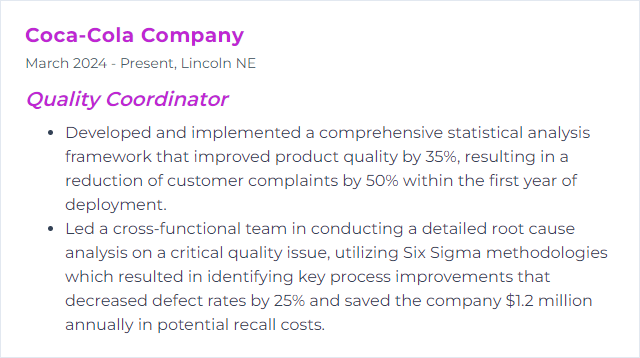
8. Risk Management
Risk management means identifying, assessing, and prioritizing risks to quality, then acting to reduce likelihood or impact. The goal: protect standards, compliance, and customer satisfaction.
Why It's Important
It prevents surprises. A structured approach reduces defects, avoids recalls, and supports confident decision-making.
How to Improve Risk Management Skills
Make risk work visible and effective:
Identify broadly across operations, suppliers, technology, and compliance. Use brainstorming, checklists, and past incident reviews.
Assess with structure using likelihood/impact scales and a risk matrix for prioritization.
Apply FMEA to processes and designs. Address high RPN/criticality items with targeted controls.
Plan treatments to mitigate, transfer, avoid, or accept. Assign owners and due dates.
Monitor continuously with KPIs and triggers. Escalate when thresholds are breached.
Build a risk-aware culture where raising concerns is safe and expected.
Use risk tools for registers, workflows, and reporting to maintain transparency.
Align to standards and regulatory expectations relevant to your industry.
How to Display Risk Management Skills on Your Resume
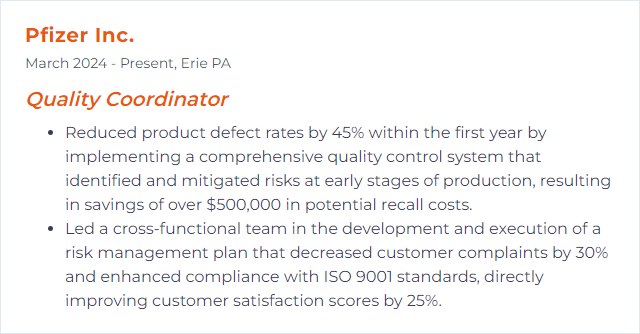
9. CAPA (Corrective and Preventive Action)
CAPA is the structured process to fix current issues (corrective) and prevent recurrence (preventive). A Quality Coordinator ensures problems are truly understood, actions are appropriate, and results stick.
Why It's Important
CAPA turns defects into durable improvements. It also demonstrates compliance and due diligence to regulators and customers.
How to Improve CAPA (Corrective and Preventive Action) Skills
Make CAPA faster, deeper, and more reliable:
Perform thorough root cause analysis with 5 Whys, Fishbone, and evidence mapping.
Use risk prioritization (e.g., FMEA inputs) to focus on the most consequential issues.
Train staff on problem-solving and documentation discipline.
Leverage data to detect trends early and spot systemic problems.
Document clearly—problem statement, containment, root cause, actions, and verification.
Involve cross-functional teams to capture all perspectives and dependencies.
Verify effectiveness with objective criteria and follow-up checks over time.
Use CAPA software to standardize workflows, approvals, and traceability.
How to Display CAPA (Corrective and Preventive Action) Skills on Your Resume

10. Minitab
Minitab is statistical software widely used for quality improvement—SPC, capability analysis, DOE, control charts, and more. Quality Coordinators rely on it to analyze processes and drive decisions.
Why It's Important
It makes advanced analysis approachable and consistent, helping identify patterns, quantify changes, and validate improvements quickly.
How to Improve Minitab Skills
Get more out of Minitab with practice and structure:
Strengthen statistics so tool choices are sound and interpretations solid.
Work through tutorials and case studies to connect features with real problems.
Practice on your own data. Build reusable templates and macros for common analyses.
Engage communities to compare approaches and troubleshoot thorny analyses.
Take targeted training from basic to advanced topics—SPC, regression, DOE, reliability.
Stay current with new releases and features that simplify workflows.
Create feedback loops between analysis and process owners to ensure insights lead to action.
Lean on support when stuck—faster resolution, better practices.
How to Display Minitab Skills on Your Resume
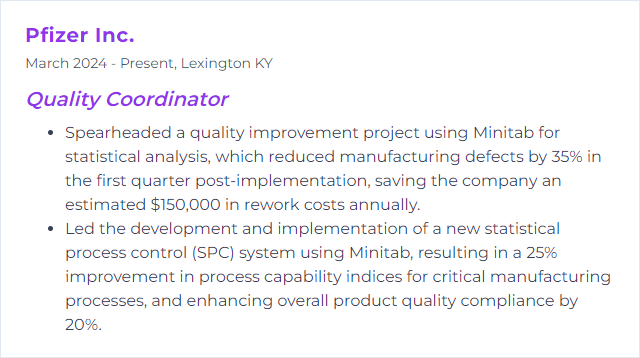
11. Project Management
Project management is planning, executing, and steering work to hit goals within time, scope, budget, and quality constraints. For a Quality Coordinator, it ensures deliverables meet the bar—every time.
Why It's Important
It aligns resources, reduces risk, and creates visibility so teams finish on time and to spec. Quality doesn’t happen by accident.
How to Improve Project Management Skills
Bring structure without the bureaucracy:
Set clear objectives and success criteria. Make them measurable and time-bound.
Embed quality planning—requirements, verification steps, and acceptance criteria—into the schedule.
Communicate openly with cadence: standups, reviews, dashboards.
Manage risk proactively with a live register, owners, and mitigations.
Use PDCA to iterate quickly and correct course early.
Engage stakeholders for alignment and timely decisions.
Adopt software tools for planning, tasking, and tracking that fit your team’s size and style.
Grow professionally with certifications and practice across Agile and Waterfall environments.
How to Display Project Management Skills on Your Resume
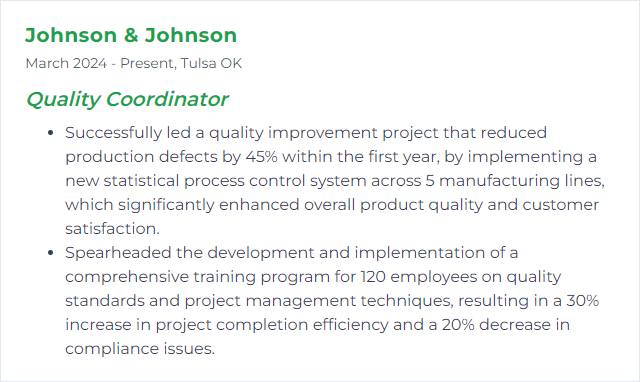
12. Continuous Improvement
Continuous Improvement is the ongoing effort to enhance products, services, and processes—incrementally and through breakthroughs—to raise efficiency and quality.
Why It's Important
It sustains momentum. Waste falls, performance climbs, customers stay. The organization learns, adapts, and keeps its edge.
How to Improve Continuous Improvement Skills
Make CI habitual and visible:
Educate and train teams on CI principles, problem-solving, and visual management.
Apply proven tools like PDCA, A3 thinking, and Six Sigma where it fits.
Engage employees with idea systems, huddles, and rapid experiments.
Set clear targets tied to customer value and strategic goals.
Measure what matters with simple KPIs and frequent reviews.
Adapt quickly based on learning. Retire what doesn’t work; scale what does.
Recognize wins to reinforce behaviors and keep energy high.
How to Display Continuous Improvement Skills on Your Resume

